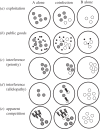Within-host competitive interactions as a mechanism for the maintenance of parasite diversity
- PMID: 26150667
- PMCID: PMC4528499
- DOI: 10.1098/rstb.2014.0301
Within-host competitive interactions as a mechanism for the maintenance of parasite diversity
Abstract
Variation among parasite strains can affect the progression of disease or the effectiveness of treatment. What maintains parasite diversity? Here I argue that competition among parasites within the host is a major cause of variation among parasites. The competitive environment within the host can vary depending on the parasite genotypes present. For example, parasite strategies that target specific competitors, such as bacteriocins, are dependent on the presence and susceptibility of those competitors for success. Accordingly, which parasite traits are favoured by within-host selection can vary from host to host. Given the fluctuating fitness landscape across hosts, genotype by genotype (G×G) interactions among parasites should be prevalent. Moreover, selection should vary in a frequency-dependent manner, as attacking genotypes select for resistance and genotypes producing public goods select for cheaters. I review competitive coexistence theory with regard to parasites and highlight a few key examples where within-host competition promotes diversity. Finally, I discuss how within-host competition affects host health and our ability to successfully treat infectious diseases.
Keywords: G×G interactions; bacteriocins; coexistence; parasite diversity; public goods; within-host competition.
© 2015 The Author(s) Published by the Royal Society. All rights reserved.
Figures

References
-
- Ewald PW. 1983. Host-parasite relations, vectors, and the evolution of disease severity. Ann. Rev. Ecol. Syst. 14, 465–485. (10.1146/annurev.es.14.110183.002341) - DOI
Publication types
MeSH terms
LinkOut - more resources
Full Text Sources
Other Literature Sources

